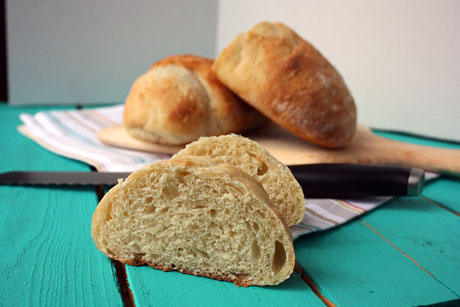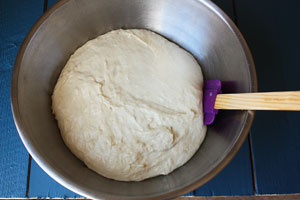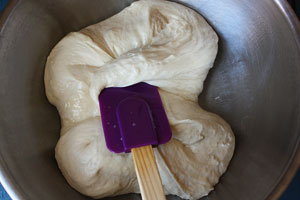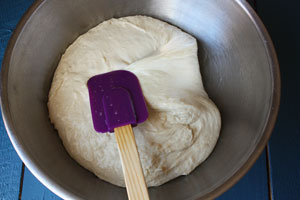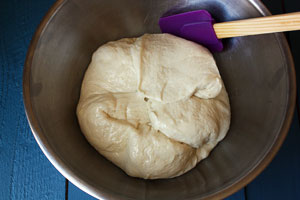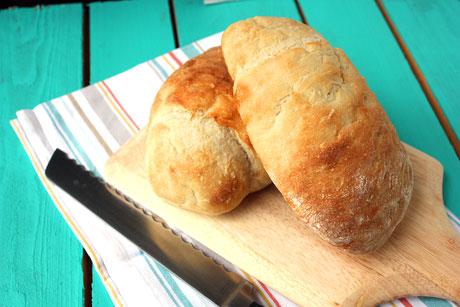The only reason I don't eat this bread every week is because it takes a little bit of planning. You have to make a biga ahead of time. What is a biga you ask? A biga is a per-ferment that is similar to a sourdough (but it's not sour). It gives great flavor and texture to the bread and helps it last longer (yay!). A biga is just four simple ingredients that you have to mix together using a spoon (no mixer required) and then place in your fridge overnight. It's really simple, but you have to think about it. That, generally, is my downfall. I wish I was better at thinking ahead of time because this bread is so worth it.
Just a note that this is a very wet and sticky dough. While it's rising, you are going to have to spray a spatula with cooking spray and stretch and fold the dough. Stay with me. It's easier than it sounds. All you do is put the spatula under the dough and then lift and fold the dough on that side in toward the middle. Then you rotate the bowl 90 degrees and do it again. You'll want to do this a total of 8 times. The reason you'll do this is to help strengthen that sticky and stretchy dough so it's a bit easier to work.
Ciabatta Recipe
Makes 4 loaves
Print this recipe
Make the biga a day before you make the ciabatta.
For the biga:
1/4 teaspoon active dry yeast
1/4 cup warm water
1 3/4 cups (8.7 ounces) bread flour
1/2 cup + 2 teaspoons cool water
For the ciabatta:
2 teaspoons active dry yeast
1 1/4 cup plus 1 tablespoon (10.5 ounces) warm water
3 cups plus 2 tablespoons (14 ounces) bread flour
2 1/2 teaspoons salt
1 biga recipe
To make the biga, dissolve the yeast in warm water in a small bowl. Let it sit for about five minutes until it's creamy. Measure the flour into a large bowl and make a well in the center of the flour. Add the yeast mixture as well as the cool water and stir it together with a large wooden spoon. Mix until sticky and well combined. Cover tightly and place in the fridge overnight.
To make the ciabatta, add the yeast and warm water in the bowl of your mixer. Let sit for five minutes until it's foamy and then add in the biga and flour and mix on low speed with the paddle attachment until well blended. Let sit for another five minutes and then add the salt. Switch to the dough hook and mix until a smooth and soft dough forms. It will be sticky. Place the dough in an oiled bowl, cover, and let rise for about an hour until doubled.
After an hour, spray a rubber spatula with cooking spray. Place the spatula under the dough in the bowl, lift it on one side and fold the dough over itself toward the middle. Turn the bowl 90 degrees and repeat. Do this 8 times. Cover the bowl and let rise for 30 minutes. After 30 minutes, repeat the lift and fold technique for 8 more turns. Cover and let rise for 30 more minutes.
Preheat your oven to 500 degrees. Cover two sheet pans with parchment paper and generously dust with flour.
Generously dust your counter with flour and place the dough on the counter gently. Be careful to not completely deflate the dough. Flour the top of the dough and divide in quarters. Take one piece of dough and place the long cut side up. Press it into a 6x3 inch rectangle (it doesn't have to be perfect). Fold the shorter sides of the dough toward the center like you were folding a business letter (in thirds). Gently transfer the folded dough to the dusted sheet pan, seam side down. Repeat with the other three pieces of dough. Place two loaves on each sheet pan. Use your finger tips to gently press down into the dough and dimple it (like you were pushing down on piano keys or a keyboard). Let rise for 30 minutes and dimple it again.
Spray the loaves lightly with water from a spray bottle and place the cookie sheet into the oven. Bake for 5 minutes, spraying the loaves with water twice more in the first 5 minutes. Reduce the heat to 475 degrees and bake for another 10-15 minutes until the loaves are golden brown and sound hollow when tapped. Cool loaves to room temperature before slicing and serving.
Source: Cook Street School of Culinary Arts
